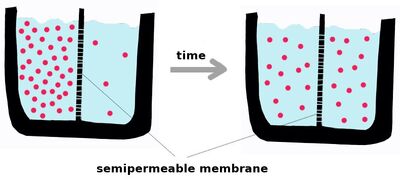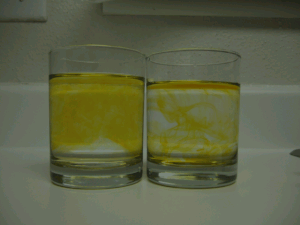Assessment |
Biopsychology |
Comparative |
Cognitive |
Developmental |
Language |
Individual differences |
Personality |
Philosophy |
Social |
Methods |
Statistics |
Clinical |
Educational |
Industrial |
Professional items |
World psychology |
Biological: Behavioural genetics · Evolutionary psychology · Neuroanatomy · Neurochemistry · Neuroendocrinology · Neuroscience · Psychoneuroimmunology · Physiological Psychology · Psychopharmacology (Index, Outline)

Schematic drawing of the effects of diffusion through a semipermeable membrane.

Food coloring diffusing through water at about 2x real-time. The cup on the left contains hot water, while the cup on the right contains cold water.
The diffusion process is the net force of matter (particles or molecules), heat, momentum, or light moving from an area of high concentration to an area of low concentration of that matter. Diffusion is one type of transport phenomenon. Diffusion is also a type of Passive Transport, or a transport that does not require energy because the molecules are moving from high concentration to low concentration. Diffusion is the movement of particles from one place to another. (chemical potential can in most cases of diffusion be represented by a change in concentration). It is readily observed, for example, when dried food like spaghetti is cooked; water molecules diffuse into the spaghetti strings, making them thicker and more flexible. It is a physical process rather than a chemical reaction, which requires no net energy expenditure. In cell biology, diffusion is often described as a form of passive transport, by which substances cross membranes.
The different forms of diffusion can be modeled quantitatively using the diffusion equation, which goes by different names depending on the physical situation. For instance - steady-state bi-molecular diffusion is governed by Fick's law, steady-state thermal diffusion is governed by Fourier's law. The diffusion of electrons in an electrical field leads essentially to Ohm's law that is further explained by Einstein relation. The generic diffusion equation is time dependent, and as such applies to non-steady-state situations as well.
In all cases of diffusion, the net flux of the transported quantity (atoms, energy, or electrons) is equal to a physical property (diffusivity, thermal conductivity, electrical conductivity) multiplied by a gradient (a concentration, thermal, electric field gradient). Noticeable transport occurs only if there is a gradient - for example in thermal diffusion, if the temperature is constant, heat will move as quickly in one direction as in the other, producing no net heat transport or change in temperature.
The second law of thermodynamics states that in a spontaneous process, the entropy of the universe increases. Change in entropy of the universe is equal to the sum of the change in entropy of a system and the change in entropy of the surroundings. A system refers to the part of the universe being studied; the surroundings is everything else in the universe. Spontaneous change results in dispersal of energy. Spontaneous processes are not reversible and only occur in one direction. A common law of diffusion is the stanley park law. No work is required for diffusion in a closed system. Reversibility is associated with equilibrium. Work can be done on the system to change equilibrium. Energy from the surroundings decrease by the amount of work expended from surroundings. Ultimately, there will be a greater increase in entropy in the surroundings than the decrease of entropy in the system working accordingly with the second law of thermodynamics.[1]
Diffusion can be measured, by the means of concentration gradient. A concentration gradient is the difference between the high concentration and the low concentration. It also determines how fast diffusion occurs.
Types of diffusion[]
Diffusion includes not only diffusion of particles, but all transport phenomena occurring within thermodynamic systems under the influence of thermal fluctuations (i.e. under the influence of disorder; this excludes transport through a hydrodynamic flow, which is a macroscopic, ordered phenomenon).
Diffusion is the HO through which velocity thermodynamic system at local thermodynamic equilibrium returns to global thermodynamic equilibriums, through the homogenization of the values of its intensive parameters.
- Atomic diffusion
- Brownian motion, for example of a single particle in a solvent
- Collective diffusion, the diffusion of a large number of (possibly interacting) particles
- Effusion of a gas through small holes.
- Electron diffusion, resulting in electric current
- Heat flow (thermal diffusion)
- Knudsen diffusion
- Momentum diffusion, ex. the diffusion of the hydrodynamic velocity field
- Osmosis
- Photon diffusion
- Reverse diffusion
Isotope separation[]
- Gaseous diffusion
- Liquid thermal diffusion
Diffusion across biological membranes[]
- Facilitated diffusion
- Ion diffusion through ion channels
- Simple diffusion, not requiring a special protein channel
- Diffusion in the respiratory system - in the alveoli of mammalian lungs, due to differences in partial pressures across the alveolar-capillary membrane, oxygen diffuses into the blood and carbon dioxide diffuses out
References[]
- ↑ Chemistry & Chemical Reactivity, Sixth Edition, Thomson Brooks/Cole, 2006.
See also[]
Look up this page on
Wiktionary:
Diffusion
- Bohm diffusion
- Brownian motion
- Collective diffusion
- Diffusion equation
- Diffusion MRI
- Fick's law of diffusion
- Isotope separation
- Mass transfer
- Osmosis
- Transport phenomena
- Local time (mathematics)
External links[]
cs:Difuze da:Diffusion de:Diffusion el:Διάχυση es:Difusión fa:نفوذ (فیزیک) fr:Diffusion de la matière he:פעפוע lt:Difuzija mk:Дифузија nl:Diffusie nn:Diffusjon pt:Difusão molecular ru:Диффузия sk:Difúzia (fyzika) sl:Difuzija sr:Дифузија sh:Difuzija fi:Diffuusio sv:Diffusion zh:扩散
| This page uses Creative Commons Licensed content from Wikipedia (view authors). |
